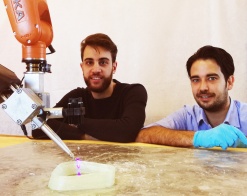What it does
Atropos is the first 6-axis robotic arm, one of a kind, able to 3D print continuous fiber composites, using thermosetting resins. This allows the creation of high performance 3D objects starting from a CAD file.
Your inspiration
Inspired by nature and silkworms, and controlled by the artifact intelligence of special algorithms, Atropos, fluently moves in space depositing a continuous fiber impregnated of thermosetting composite materials, instantly hardened as it comes out of his head. Trying to achieve the best results with the least material is not our original idea: Nature offers many examples of this approach, and some of these solutions are based on fibers indeed. Spider silk and silkworms are one of the classical examples but also trees and our tendons are fibrous. Basically, we have composites around us everyday.
How it works
The process supporting Atropos has been named “Continuous Fiber Composites Smart Manufacturing” and has been developed and patented at the Department of Chemistry, Materials and Chemical Engineering “Giulio Natta” of Politecnico di Milano (Italy). Fibers are impregnated and drawn to the head of a numerically-controlled machine able to deposit them in a precise and repeatable manner. Once extruded by the printing head, the material is irradiated by a dedicated polymerization apparatus, able to cure the matrix quickly and obtain the 3D ojbect. Continuous fiber composites materials have the peculiar characteristic of being used for the production of high performance objects. Since composites are anisotropic materials, the performance of these objects strongly depends on the orientation of the fibers. Using our smart algorithms for the deposition of the fibers, it is possible to change their direction pointwise, thus creating the best constructive solution.
Design process
From the manufacturing viewpoint, the process is always in evolution. We started to develop this project in 2014, modifying a commercially available 3-axis numerically controlled machine working at a printing speed of 1 mm/s. In this way we could demonstrate the feasibility of the proposed technology and we could patent the process (WO2017085649 A1). In September 2016 we have been lent a 6-axis robotic arm which allowed us to exploit all the potentialities of robotics. In a couple of weeks from then we were able, for example, to better orient the fiber in the direction of the maximum stress expected to occur to the final object, with the idea of implementing a slicing software capable of handling the tool path starting from the FEM analysis of the 3D model. Today the technology is able to print fiberglass-based composites at a maximum speed of 50 mm/s. In these conditions we printed the first samples for mechanical tests obtaining a tensile modulus of over 30 GPa, meaning that the material have the same performances of the traditional manufacturing methods.
How it is different
• This new additive manufacturing process, if properly implemented, is able to quickly produce continuous fiber composite objects characterized by high performance and complex shapes that today are hard to obtain. It is possible to 3D print different fibers to reinforce several thermosetting matrices. • The fibers can be oriented pointwise along the principal stress axis of the final printed object, according to the predicted solicitations they will withstand. • This allows the formation of complex structures where the reinforcement is placed only along optimal directions and in the optimal concentration to achieve the best constructive solution. • It is also possible to change the relative amount of fibers and matrix during the printing process and combine different fibers to obtain hybrid materials. • The technology can be scaled up to produce objects of big dimensions with a high added value.
Future plans
In the next few months we plan to improve the system to increase printing speed, process automatization and, above all, print composites with carbon and aramid fibers. For these reasons, we are currently investigating alternate resin formulations capable of being cured by means of energy sources other than UV light. Our dream is to launch a start-up with the purpose of realize on-demand customized and high performance products of all dimensions for sectors like automotive, biomedical or aerospace.
Awards
2017 JEC Innovation Award (Paris)



Share this page on
LinkedIn
Facebook
Twitter